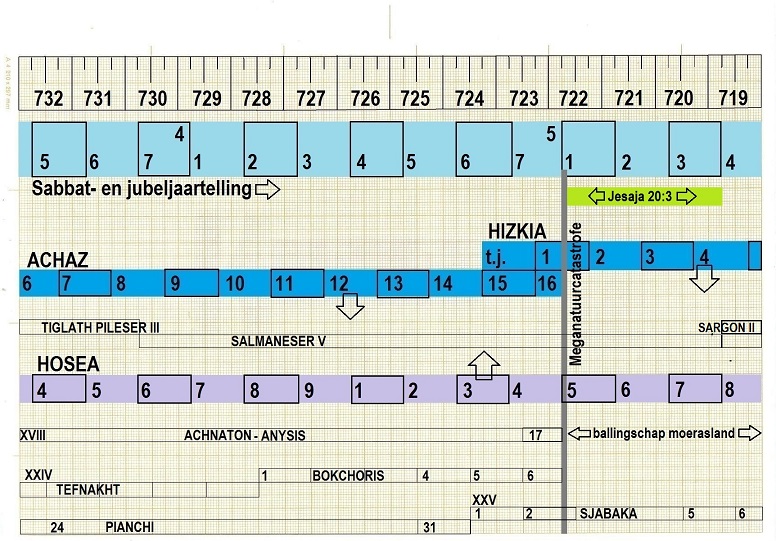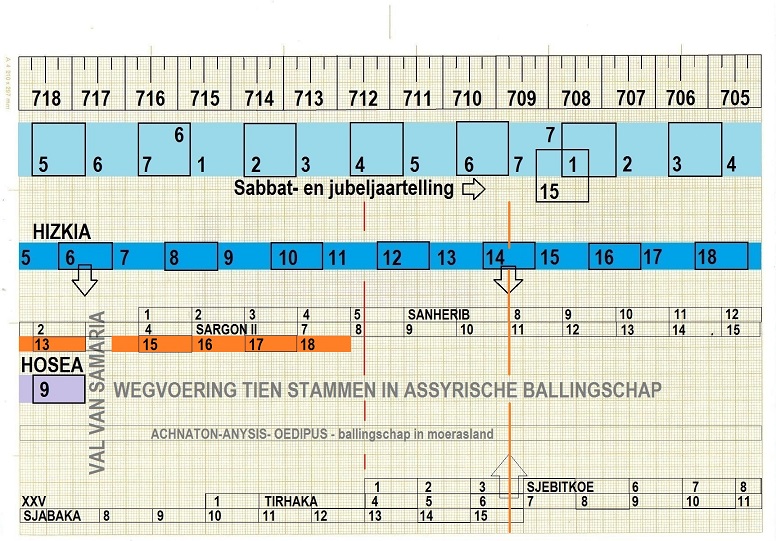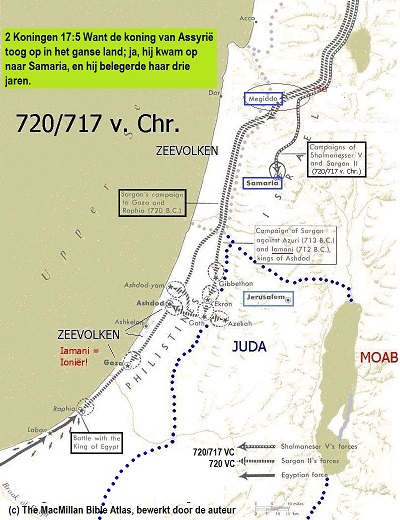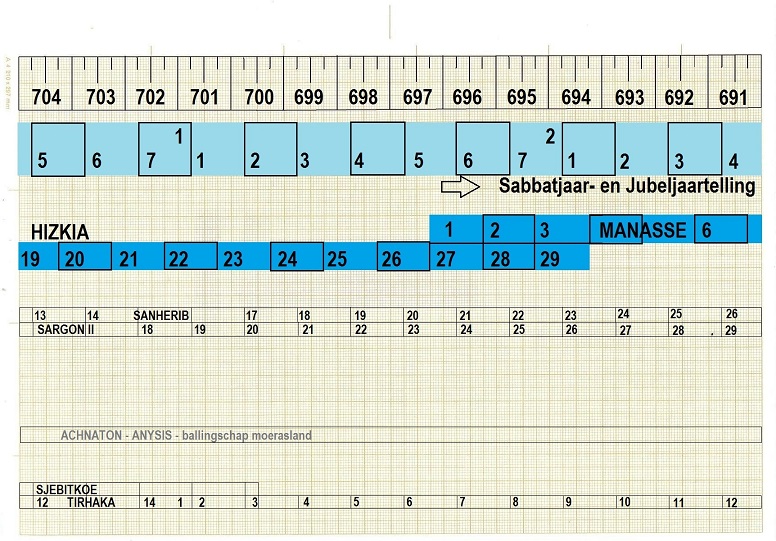With the article published on 16.09.2019 we discussed the revision of the reign of the Assyrian
king Shalmaneser V in light of the Bible and Flavius Josephus. The Assyrian
king Shalmaneser V was brought in chronological line with the contemporary
kings of Judah and Israel of the time. Assyriology has a fundamentalist
approach in the way they present their Assyrian kings-list and its fixing on
the timeline of history. Their bearing point is the reported Sun eclipse during
the eponym of Bur-Sagale over Nineveh in 763 BC. This may be correct, their
teaching however that no names in the kings list nor the Eponym lists are
missing or were ever deleted is impossible to accept. Other historical sources
like the Bible and the historian Flavius Josephus learn different. I will show that
certain Assyrian kings-names definitely were deleted from the kings list and
that on several occasions in their history the Assyrian kings had co-regencies
and consequently it is the Assyrian kings list and its modern chronology that
needs adjusting.
This
week we continue with the successor of Shalmaneser V: the usurper Sargon II. Traditionally Sargon II is
given a period of sole reign from 723/722 till 705/704 BC based on the interpretation
of the Eponym-list. As was the case with Shalmaneser V using solely the
Eponym-lists to determine the years of reign and the anchor-points on the time-line
leads into error. It should be the Bible and the historian Flavius Josephus for
use of anchor points on the timeline of history. Sargon II is mentioned by name
in the Bible:
Isaiah 20:1 In the year that
Tartan came unto Ashdod, (when Sargon the king of Assyria sent him,)
and fought against Ashdod, and took it; 2 At
the same time spake the Lord by Isaiah the son of Amoz, saying, Go and
loose the sackcloth from off thy loins, and put off thy shoe from thy foot. And
he did so, walking naked and barefoot. 3 And the Lord said, Like as my servant
Isaiah hath walked naked and barefoot three
years for a sign and wonder upon Egypt and upon Ethiopia; 4 So shall the king of Assyria lead away the
Egyptians prisoners, and the Ethiopians captives, young and old, naked and
barefoot, even with their buttocks uncovered, to the shame of Egypt. 5 And they
shall be afraid and ashamed of Ethiopia their expectation, and of Egypt their
glory. 6 And the inhabitant of this isle shall say in that day, Behold, such is
our expectation, whither we flee for help to be delivered from the king of
Assyria: and how shall we escape?

© Robert De Telder, Dertig Jubeljaren, 2018, page 265
The prophet Isaiah places Sargon II on the time line
in the year 719 BC at the time the Assyrians besieged Ashdod after the prophet
had walked barefoot in the land for a period of three years as a sign.
The other historical Books of the Bible do not mention
Sargon II by name but instead refer during the époque we are studying now to
the kings of Assyria, kings in plural. We will show that also Sargon II
shared the crown with others, firstly with Shalmaneser V and secondly with
Sennacherib his successor. Sargon II during his co-regency with Salmaneser V
was subservient to him. Using the prophecy of Isaiah as a bearing point on the
time line we can state that Sargon II was a co-regent of Shalmaneser V at that
time. That observation however does not show itself in the preserved annals of
Sargon II. The fall of Samaria in 717 BC for instance is claimed by Sargon II
there where the Bible says it was Salmaneser V.
Annals
of Sargon: 7. I besieged and occupied
the town of Samaria, and took 27,280
of its inhabitants captive. I took from them 50 chariots, but left them the
rest of their belongings. I placed my Lieutenants over them; I renewed the
obligation imposed upon them by one of
the Kings who preceded me.
(Excerpted
from "Great Inscription in the Palace of Khorsabad," Julius Oppert,
tr., in Records of the Past, vol. 9 (London: Samuel Bagster and Sons, 1877),
pp. 3-20)

© Robert De Telder, Dertig Jubeljaren, 2018, page 266
The Bible states in
contradiction that it was Shalmaneser who besieged and took Samaria. The Bible
unmasks Sargon II in fact as a forger of history.
2 Kings 18:9 And it came to pass in the fourth year of king Hezekiah,
which was the seventh year of Hoshea son of Elah king of Israel, that Shalmaneser king of Assyria came up
against Samaria, and besieged it. 10
And at the end of three years they took it: even in the sixth year of Hezekiah,
that is the ninth year of Hoshea king of Israel, Samaria was taken. 11 And the king of Assyria did carry away
Israel unto Assyria, and put them in Halah and in Habor by the river of Gozan,
and in the cities of the Medes: 12 Because they obeyed not the voice of the
LORD their God, but transgressed his covenant, and all that Moses the servant
of the LORD commanded, and would not hear them, nor do them. (KJV)
Since we have Sargon
II mentioned as king over Assyria in the Bible in the year 719 BC when Ashdod
was besieged, he is as such proven to have been a co-regent or with Shalmaneser
V at the fall of Samaria in 717 BC. In fact we can reconstruct from the Bible
what really happened between the years 720 till 717 BC.

The two Assyrian
armies one lead by Sargon II and the other lead by Salmaneser V descended south
together till Megiddo where they split with the army of Sargon II moving
towards Ashdod and the army of Salmaneser V marching on Samaria where a three
year long siege was started. The eponym list does not refer to the siege of
Samaria at all and in fact has a gap shown with several years missing.
The siege and fall
of Samaria is based on Biblical chronology firmly fixed in the years 720/717
BC. While Shalmaneser V was besieging Samaria the Eponym-list mentions the
following brief activities of Sargon II:
[719/718]
During the eponomy of Sargon [II], the king of Assyria entered [.?.].
[718/717]
During the eponomy of Zeru-ibni, the governor of Rasappa, campaign against Tabal.
[717/716]
During the eponomy of Tab-¹ar-A¹¹ur, the chamberlain, Dur-©arruken [the new capital
of Assyria] was founded.
The
eponym of Sargon II has the king of Assyria entered (?) between brackets. We
can however fill in from his preserved annals that he campaigned in Elam that
year: 6. This is what I did from the beginning of my reign to my fifteenth
year of reign : I defeated KHUMBANIGAS, King of Elam, in the plains of Kalu.
While
his tartan or field Marshall was at Ashdod with an army Sargon II was
campaigning in the east.
The
annals we refer to are the ones that decorated the walls of his palace. On it
Sargon II seems to have been omnipotent. Also the siege and victory over
Samaria is found in this section on the wall:
7.
I besieged and occupied the town of Samaria, and took 27,280 of its inhabitants
captive. I took from them 50 chariots, but left them the rest of their
belongings. I placed my Lieutenants over them; I renewed the obligation imposed
upon them by one of the Kings who preceded me.
8.
HANUN, King of Gaza, arid SEBECH, Sultan
of Egypt, allied themselves at Rapih to oppose me, and fight against me;
they came before me, I put them to flight. SEBECH
yielded before my cohorts, he fled, and no one has ever seen any trace of him
since. I took with my own hand HANUN, King of Gaza.
9.
I imposed a tribute on PHARAOH, King of Egypt, SAMSIE, Queen of Arabia,
IT-AMAR, the Sabean, of gold, sweet smelling herbs of the land, horses, and
camels.
We
noticed earlier in our reconstruction that in fact the army of Sargon II moved
against Ashdod and marched on towards the Egyptian border while the army of
Shalmaneser V laid siege to Samaria. At Raphia on the Egyptian border the army
of Egypt under the leadership of a certain Sebech was defeated by the
Assyrians. This Sebech must be a Assyrian variant of the Biblical pharaoh
So in whom the last king of Israel Hoshea had put his trust. The defeat of
the Egyptian army under So by the Assyrian army of Sargon II at the border
sealed the fate of Samaria under siege by the army of Shalmaneser V. The
prophecy of Isaiah Chapter 20:4 regarding Egypt was herewith fulfilled.
The
following year 718/717 BC according to the Eponym list has Sargon II
campaigning against Tabal. This place is situated in the northwest of Assyria.
This campaign is also preserved in detail on his palace walls:
11.
Amris of Tabal, had been placed upon the throne of KHULLI his father; I gave to
him a daughter and I gave him Cilicia which had never submitted to his
ancestors. But he did not keep the treaty and sent his ambassador to URZAHA,
king of Armenia, and to MITA, King of the Moschians, who had seized my
provinces. I transported Amris to Assyria, with his belongings, the members of
his ancestors' families, and the magnates of the country, as well as 100
chariots; I established some Assyrians, devoted to my government, in their places.
I appointed my Lieutenant Governor over them, and commanded tributes to be
levied upon them.
The
following year 717/716 BC while Shalmaneser s army finished the siege of
Samaria by capturing it Sargon II started building his new capital: Dur-©arruken
a place situated near modern Khorsabad in today s Iraq. To the west the army
of Sargon II campaigned that year against Hamath. The fate of the defeated king
of Hamath defies all imagination:
12.
JAUBID of Hamath, a smith, was not the legitimate master of the throne, he
was an infidel and an impious man, and he had coveted the royalty of Hamath. He
incited the towns of Arpad, Simyra, Damascus, and Samaria to rise against me, took his precautions with each of them,
and prepared for battle. I counted all the troops of the god Assur; in the town
of Karkar, which had declared itself for the rebel, I besieged him and his
warriors, I occupied Karkar and reduced it to ashes. I took him, himself, and had him flayed, and I killed the
chief of the rioters in each town, and reduced them to a heap of ruins. I
recruited my forces with 200 chariots and 600 horsemen from among the
inhabitants of the country of Hamath and added them to my empire.
Hereafter
follow the remaining eponym-list regarding Sargon II:
[716/715]
During the eponomy of Tab-sil-E¹arra, the governor of Libbi-ali, campaign
against Mannea.
Comment: The year 716 BC was the year Sennacherib became a co-regent of
Sargon II. In a following article this will be discussed in detail.
[715/714]
During the eponomy of Taklak-ana-b�li, the governor of
Nisibis, governors were appointed.
Comment: While the co-king Shalmaneser V is besieging Tyrus the
eponym-list only mentions the appointment of governors while the annals of
Sargon II have him capturing Karkemis. The fact that the taking Karkemis is not
mentioned in the eponym-list leaves a question-mark.
[714/713]
During the eponomy of I¹tar-duri, the governor of Arrapha, campaign against
Urartu and Musasi; [the statue of the god] Haldi was deported.
Comment: While Shalmaneser V is still besieging Tyrus (according to
Flavius Josephus) Sargon II is campaigning against Urartu.
[713/712]During
the eponomy of A¹¹ur-bani, the governor of Kalhu, the nobles fought at Ellipi;
the god [...] entered his new temple, to Musasir.
Comment: This year is the fourth year of the five-year siege of Tyrus by
Shalmaneser V. Sargon II went to Musasir which was an important mountain-city
in Urartu.
[712/711]
During the eponomy of ¹arru-emuranni, the governor of Mazamua, the king stayed in the land.
Comment: the king stayed in the land is a euphemism for doing nothing.
The year 712 BC is the year of the invasion of the Sea Peoples in the
Levant and Egypt. The invasion and its revision on the time line of history had
my attention in my published book (in Dutch) De zonaanbidder, 2016, appendix
1, page 149-158. The prophet Isaiah described the invasion in detail in his
chapters 15/18. The year 712 BC was obtained with the revision of the years of
reign of Ramses III. Ramses III was according to my revision one of the twelve
kings that followed the priest-king Sethos (Herodotos Book 2, 147), the latter
firmly fixed in the 8th Century BC by Herodotos.
[711/710]
During the eponomy of Inurta-alik-pani, the governor of Si'immel, campaign
against Mar'a¹.
Comment: The invasion of the Sea Peoples in 712
BC was halted by Ramses III the same year. Sargon residing in the heartland of
Assur remained unharmed and was as such able to carry out his campaign against
Maras the next year. In the meantime along the coast of the Levant some of the
Sea Peoples had remained and settled there. In Asdod a Greek (Ionian) ruler had
established himself as king over the region. In his preserved annals Sargon
referred to the Greeks who had settled themselves in Asdod.
32.
AZURI, King of Ashdod, determined
within himself to render no more tributes; he sent hostile messages against
Assyria to the neighboring Kings. I meditated vengeance for this, and I
withdrew from him the government over his country. I put his brother AKHIMIT on
his throne. But the people of Syria, eager for revolt, got tired of AKHIMIT's
rule, and installed IAMAN, who like the
former, was not the legitimate master of the throne. In the anger of my
heart, I did not assemble the bulk of my army nor divide my baggage, but I marched
against Ashdod with my warriors, who did not leave the trace of my feet.
33.
IAMAN learnt from afar of the
approach of my expedition; he fled beyond Egypt towards Libya (Meluhhi), and no
one ever saw any further trace of him. I besieged and took Ashdod and the town
of Gimtu-Asdudim; I carried away captive IAMAN'S gods, his wife, his sons, his
daughters, his money and the contents of his palace, together with the
inhabitants of his country. I built these towns anew and placed in them the men
that my arm had conquered.
34.
I placed my Lieutenant as Governor over them, and I treated them as Assyrians. They
never again became guilty of impiety.
[710/709]
During the eponomy of ©ama¹-b�la-usur, the governor of Ahizuhina, campaign against
Bit-zeri [against the Babylonian ruler Marduk-apla-iddina, who was defeated];
the king stayed in Ki¹.
[709/708]
During the eponomy of Mannu-ki-A¹¹ur-le'i, the governor of Tille, Sargon took the hand of B�l [and became king of Babylonia].
Comment: This statement of Sargon II becoming king over Babylon in
709/708 BC is confirmed by the Ptolemy-canon. In the spring of 709 BC
Sennacherib the son of Sargon II was besieging Jerusalem with his own army but was defeated. The spring of 709 was the 14th year of reign of Hezekiah
(Oct 710/Sep 709 BC) based on the new chronology of the kings of Judah by
applying the Sabbath and Jubilee years of reckoning. With the following article
on Sennacherib this will be worked out in detail.
38.
MERODACH-BALADAN, son of IAKIN, King of
Chaldaea, the fallacious, the persistent in enmity, did not respect the
memory of the gods, he trusted in the sea, and in the retreat of the marshes;
he eluded the precepts of the great gods, and refused to send his tributes. He
had supported as an ally KHUMBANIGAS,
King of Elam. He had excited all the nomadic tribes of the desert against
me. He prepared himself for battle, and advanced. During twelve years,[ From
721 to 709 BC] against the will of the
gods of Babylon, the town of BEL, which judges the gods, he had excited the
country of the Sumers and Accads, and had sent ambassadors to them. In honor of
the god Assur, the father of the gods, and of the great and august Lord
MERODACH, I roused my courage I prepared my ranks for battle. I decreed an
expedition against the Chaldeans, an impious and riotous people. MERODACH-BALADAN heard of the approach
of my expedition, dreading the terror of his own warriors, he fled before it,
and flew in the nighttime like an owl, falling back from Babylon, to the
town of Ikbibel.
Comment: The defeat of Merodach Baladan, king of Babylon, by Sargon II
as mentioned in his annals established to be 709 BC shows that using the eponym
list solely as a guiding point delivers false navigation points of the time
line of history. The Bible refers to Berodachbaladan visiting Hezekiah after
the defeat of the Assyrian army of Sennacherib.
2
Kings 20:12 King James Version (KJV) At that time Berodachbaladan, the son of
Baladan, king of Babylon, sent letters and a present unto Hezekiah: for he had
heard that Hezekiah had been sick. 13 And Hezekiah hearkened unto them, and
shewed them all the house of his precious things, the silver, and the gold, and
the spices, and the precious ointment, and all the house of his armour, and all
that was found in his treasures: there was nothing in his house, nor in all his
dominion, that Hezekiah shewed them not.
According to Biblical chronology this history belongs on the time line
of history after the defeat of the Assyrian army of Sennacherib in 709 BC. It
was after the siege that Hezekiah became ill and 15 years were added to his
lifespan. The visit of Merodach Baladan took place after the failed siege of
Jerusalem by Sennacherib in Oct. 709/sept 708 BC and falls within the years of reign of Sargon II as
stated by the Ptolemy canon.
The biblical chronology as fabricated by Edwin R. Thiele on basis of the
reign of Sennacherib according to the eponym list has as a result a wandering
king of Babylon visiting Jerusalem in 701/700 BC.
[708/707]
During the eponomy of ©ama¹-upahhir, the governor of Habruri, Kummuhu was
captured; a governor was appointed.
[707/706]
During the eponomy of ©a-A¹¹ur-dubbu, the governor of Tu¹han, the king returned
from Babylon; the chief vizier, the nobles, the booty of Dur-Yakin was carried
off; [...] Dur-Yakin was destroyed; in Ta¹r�tu, the
twenty-second, the gods of Dur-©arruken entered their temples.
[706/705]During
the eponomy of Mutakkil-A¹¹ur, the governor of Guzana, the king stayed in the land; the nobles were in Karalla; in Ajaru,
the sixth, Dur-©arruken was completed; [...] received.

© Robert De Telder, Dertig Jubeljaren, 2018, page 267
To
be continued
Robert
De Telder
Recent
publications (Dutch):
see link: https://boekentips.com/auteur/2508383/robert-de-telder
